Ah, green onions – the versatile vegetable that adds a zingy, oniony flavor to many a dish. Green onions, also known as scallions, are indigenous to China where they have been used in Chinese cuisine for thousands of years. In traditional Chinese herbal medicine, green onions have been used for their anti-inflammatory and antioxidant effects. The good news is that you don’t need a green thumb to cultivate your own bunch of green onions. So let’s get down to the root of the matter and dig into the world of Alliums. Keep reading for your complete guide on how to grow green onions.
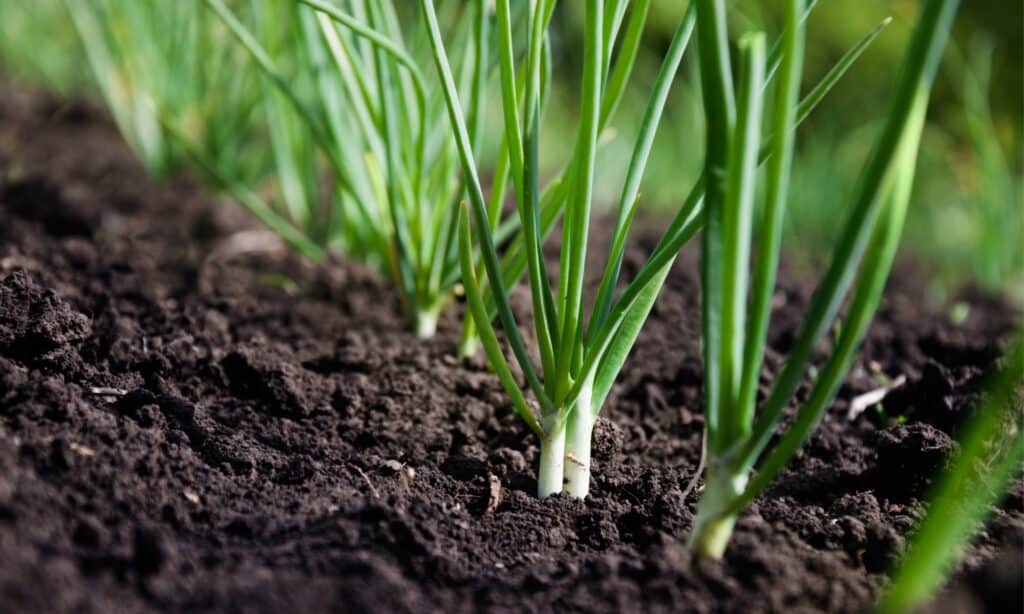
The good news is that you don’t need a green thumb to cultivate your own bunch of green onions.
©iStock.com/Zoya2222
What are Green Onions?
Green onions (Allium fistulosum), also known as spring onions, are a type of young onion that is harvested before the bulb has fully developed. They are typically characterized by their long, slender green stalks and small, white, slightly bulbous roots.
Green onions are part of the Allium family, which also includes garlic (Allium sativum), leeks (Allium ampeloprasum), and regular onions (Allium cepa). They have a mild onion flavor and are commonly used as a garnish in various dishes such as soups, salads, and stir-fries. The term spring onion is often used interchangeably with green onion. Green onions are a versatile and flavorful ingredient that can be used to add depth and complexity to many culinary endeavors.
Green onions are often used whole, including both the green tops and white bulbs, in many dishes. However, the green tops are usually the most flavorful part and are often used as a garnish or added towards the end of cooking to preserve their freshness and crisp texture. The white bulbs are also flavorful and can be used in cooking, but are usually milder in taste than regular bulb onions.
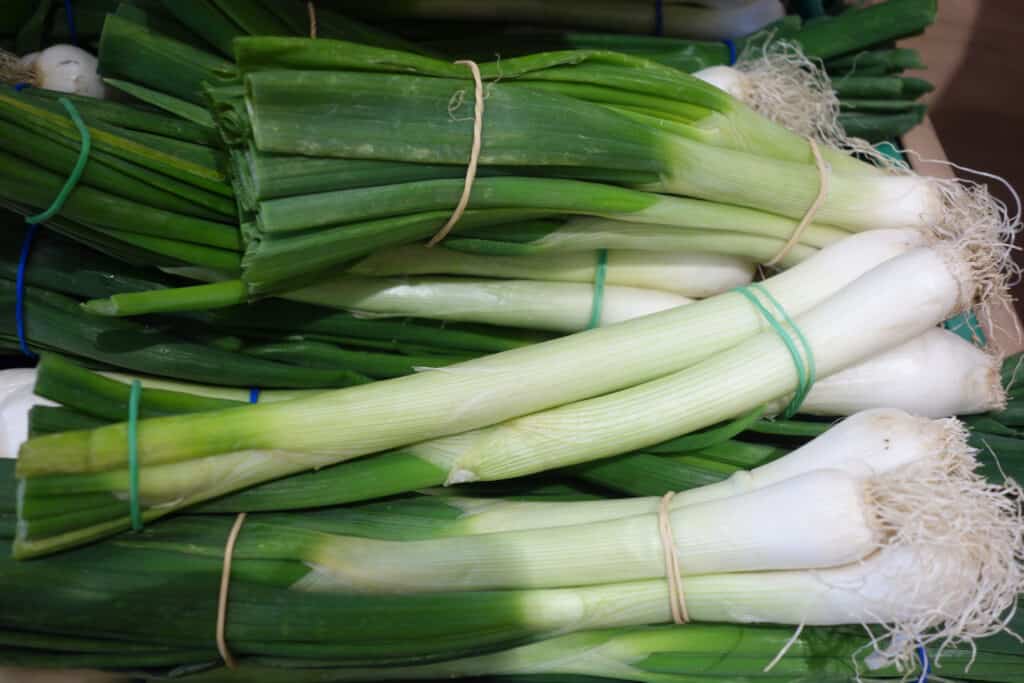
Green onions are often used whole, including both the green tops and white bulbs.
©iStock.com/Elmar Gubisch
How to Grow Green Onions: Selection
There are several varieties of green onions, which are also known as scallions or spring onions. Some of the most common varieties include:
1 Evergreen Bunching Onions: These are the most commonly found green onions in supermarkets. They have a long, slender stem and a small, white bulb. They are also known as Japanese bunching onions.
2 White Lisbon: This is a popular variety in Europe. It has a long, slender stem and a small, white bulb. It is commonly used in salads, soups, and stir-fries.
3 Red Welsh Onion: This is a red-skinned variety of green onion. It has a milder flavor than other types and is often used in soups and stews.
4 Egyptian Onion: This variety has a small, bulbing stem and is commonly used in Asian cuisine.
5 Chinese onion: This variety has a thicker stem than other green onions and a milder, sweeter flavor. It is often used in stir-fries and dumplings.
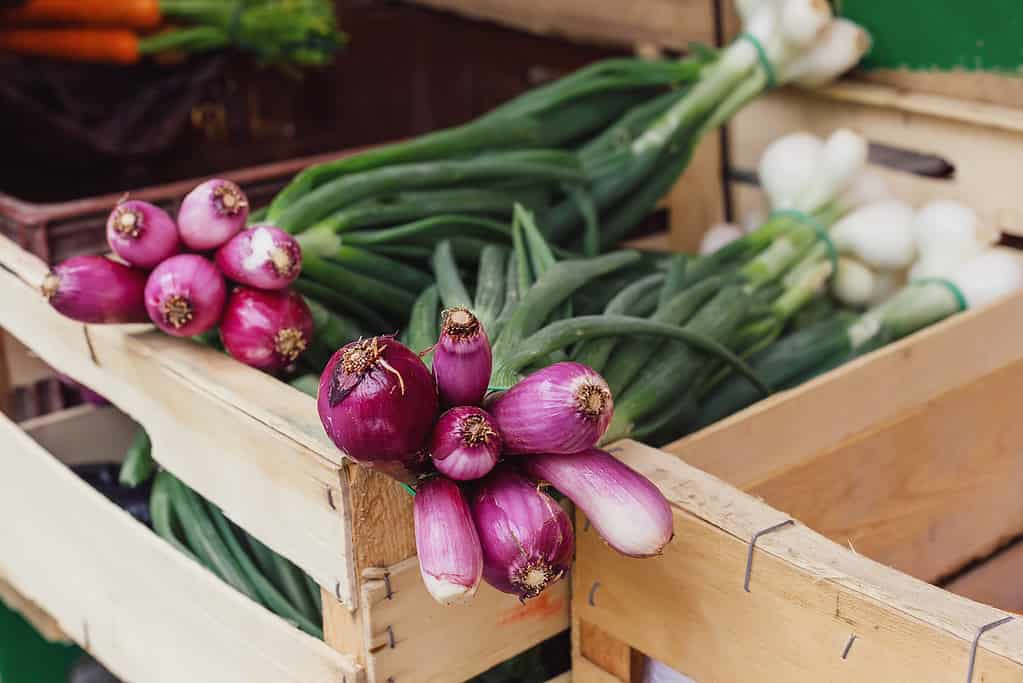
There are several varieties of green onions, which are also known as scallions or spring onions.
©tianalima/Shutterstock.com
How to Grow Green Onions: Preparing the Bed
Choosing a suitably sunny location and turning the soil are essential steps in preparing to plant your green onion seed. Green onions prefer full sun to partial shade, so it’s important to choose a location that receives at least 6 hours of direct sunlight per day. This can be a garden bed, a container, or even a sunny windowsill if you are starting the seeds indoors.
Once you have chosen your location, it’s important to prepare the soil. Green onions prefer loose, well-draining soil that is rich in organic matter. To prepare the soil, remove any weeds or debris and turn the soil over to a depth of at least 6 inches. This will loosen the soil and create a nice, soft bed in which the seeds can germinate and grow.

Choosing a suitably sunny location and turning the soil are important steps in preparing to plant your green onion seed.
©Singkham/Shutterstock.com
Soil pH
Green onions prefer a slightly acidic soil pH between 6.0 and 6.8. However, they can still grow in slightly alkaline soil with a pH of up to 7.5. Soil pH affects the availability of nutrients to plants. If your soil is too alkaline, you may need to amend it with organic matter or sulfur to lower the pH. If you’re not sure about the pH of your soil, you can purchase a soil test kit at your local garden center. Alternatively, your local extension office will be happy (for a nominal fee) to test your soil for you.

Green onions prefer a slightly acidic soil pH between 6.0 and 6.8.
©iStock.com/kb79
Container Selection
If you are planting your green onions in a container, choose one that is at least 6-8 inches (16-20 cm) deep and has good drainage. Fill the container with a high-quality potting mix that is rich in organic matter and provides good drainage.
Whether you are planting in the ground or in a container, it’s a good idea to add some compost. Organic matter added to the soil helps provide nutrients to the growing plants. You can also add a balanced fertilizer to the soil to give the plants a little extra boost.
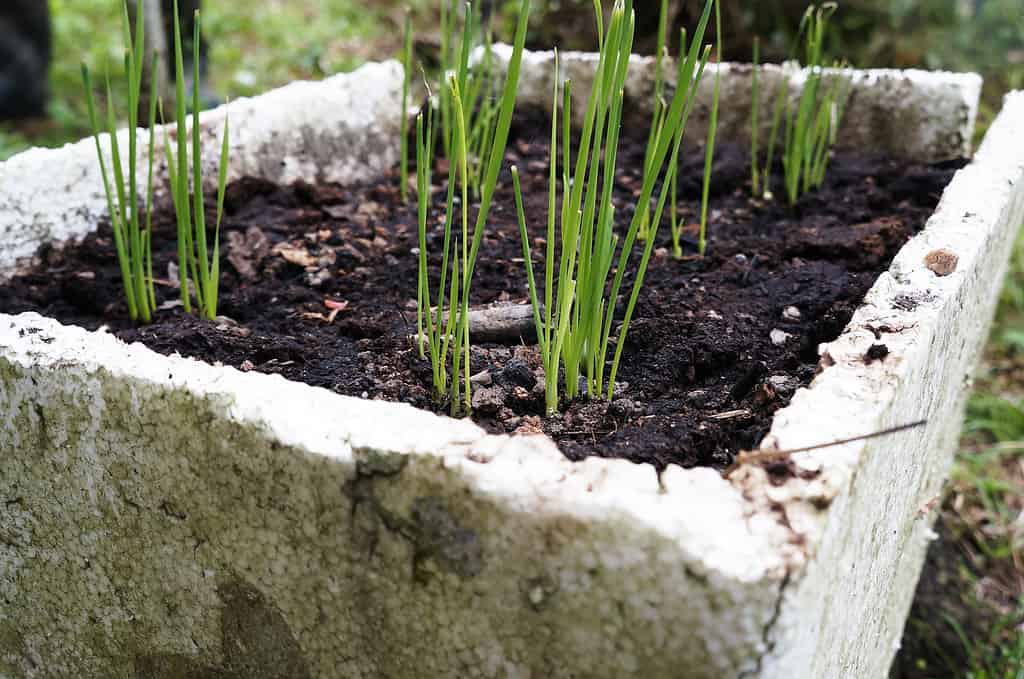
If you are planting your green onions in a container, choose one that is at least 6-8 inches (16-20 cm) deep and has good drainage.
©attem/Shutterstock.com
How to Grow Green Onions: Planting Methods
Planting green onions from seed is a relatively easy process that can be accomplished in a few simple steps. The first step is to decide whether to start the seeds indoors or sow them directly into the soil. Starting seeds indoors is a good option if you want to get a head start on the growing season. This is particularly true for those who garden in colder climates with a late last frost.

Starting seeds indoors is a good option if you want to get a head start on the growing season or if you live in a colder climate with a late last frost.
©VVVproduct/Shutterstock.com
Starting Seed Indoors
Start green onion seeds indoors, 4-6 weeks before the last frost date in your area. Fill a seed tray with seed-starting mix. Press the seeds into the soil, leaving about ¼ inch (0.6 cm) of space between each seed. Keep the soil evenly moist and place the tray in a warm, sunny location or under grow lights. Once the seedlings have grown to be about 4-6 inches (10-16 cm) tall and the danger of frost has passed, they can be transplanted outdoors.
Direct Sowing Method
If you choose to sow the seeds directly into the soil, wait until after the danger of frost has passed and the soil has warmed up. Green onions require a soil temperature of 45 degrees F (8 C) to germinate. Sow the seeds directly into the soil, spacing them about 1 inch (2.5 cm) apart and covering them with a thin layer of soil. Keep the soil moist, and within 7-10 days the seeds should germinate and begin to grow.
It’s important to keep the soil consistently moist and to thin the seedlings as they grow, spacing them 2-3 inches (5-7 cm) apart. Green onions can be grown spring through fall in more temperate regions where the summers do not get too hot, with successive plantings every few weeks to ensure a steady supply of fresh onions. Green onions reach maturity 50-65 days after the seeds are sown.
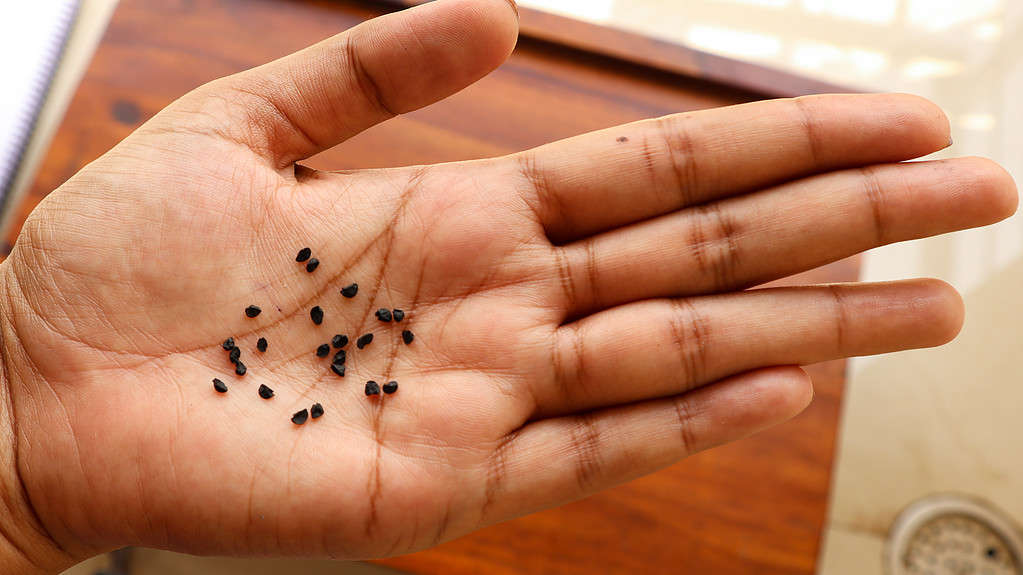
If you choose to sow the seeds directly into the soil, wait until after the danger of frost has passed and the soil has warmed up. Green onions require a soil temperature of 45 degrees F (8 C) to germinate.
©Tottochan/Shutterstock.com
Container Gardening
Green onions grow well in containers on a patio, balcony, or window sill. As long as they have enough room to develop their roots and receive adequate sunlight and water, you should reap a bountiful harvest. Tips for growing green onions in containers:
- Choose a suitable container: Green onions don’t need a large container to grow, but it should be deep enough to allow the roots to develop fully. A container that is at least 6-8 inches (15-20 cm) deep and has drainage holes is ideal.
- Use good quality soil: Use good quality potting soil or a mix of compost and sand to ensure that the soil is well-draining.
- Planting: Sow seed, sow seeds about 1/4 inch (0.6 cm) deep and 1 inch (2.5 cm) apart.
- Watering: Water the plants regularly, keeping the soil evenly moist.
- Fertilizing: You can apply a balanced fertilizer once a month during the growing season.
- Harvesting: Green onions can be harvested when the stems reach a thickness of about 1/4 to 1/2 inch, approximately 50-65 days after planting the seed. You can either pull up the entire plant or cut the stems off at the base.
How to Grow Green Onions: USDA Hardiness Zones
Green onions are a cold-hardy crop that can be grown in a wide range of USDA Hardiness Zones. In fact, they are considered one of the easiest vegetables to grow, making them a great choice for new gardeners! Generally speaking, green onions can be grown in Zones 3 through 10, which covers most of the continental United States. If you aren’t certain which zone you garden in, you can figure it out here.

Green onions can be harvested approximately 50-65 days after planting the seed.
©iStock.com/Dumitru Ochievschi
Five Fun Facts about Green Onions
- The song Green Onions is a classic instrumental track recorded by Booker T. & the M.G.’s in 1962. The song features a distinctive organ riff and has been used in numerous films, TV shows, and commercials over the years. It remains a popular and recognizable tune to this day.
- The Calcot Festival is a traditional Catalan festival that takes place in the town of Valls, Spain. The festival celebrates the calcot, which is a type of green onion that is native to the region. The festival is centered around a massive barbecue, where thousands of calcots are grilled over open fires. The calcots are served with a special sauce called romesco, which is made from almonds, hazelnuts, red peppers, garlic, and olive oil. The festival includes music, dancing, parades, and other cultural activities, and it attracts visitors from all over Catalonia and beyond. The Calcot Festival is a beloved tradition in the region, and it is a wonderful way to experience Catalan culture and cuisine.
- Green onions are packed with nutrients: They are a good source of vitamin C, vitamin K, and fiber.
- In addition to their nutritional value, green onions have been shown to have anti-inflammatory, anti-bacterial, and anti-viral properties.
- Green onions contain natural insecticides that can help repel pests in the garden.
The photo featured at the top of this post is © iStock.com/Zoya2222
Thank you for reading! Have some feedback for us? Contact the AZ Animals editorial team.






